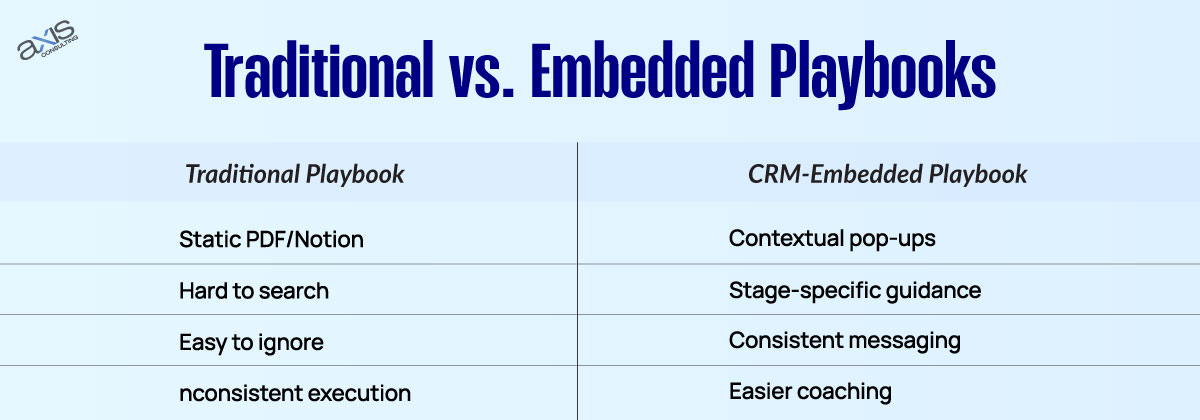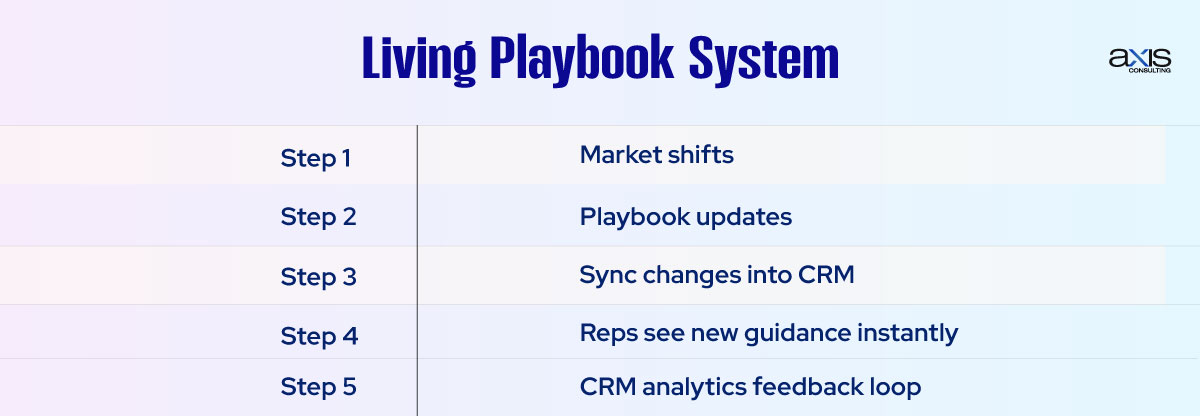You spent weeks building a sales playbook. It’s beautiful. Full of buyer personas, objection handling, and qualifying questions. It lives in a PDF or a Notion doc, proudly pinned in Slack. But here’s the truth: if your playbook isn’t inside your CRM, your reps probably aren’t using it.
A sales playbook only drives results when it shows up where reps work inside the CRM, embedded in their daily workflow. That’s where strategy becomes action, and consistency becomes real.
Table of Contents
ToggleThe Problem with Traditional Sales Playbooks

Most sales playbooks sit outside of the tools reps use every day. They’re static, hard to search, and easy to ignore. Reps don’t have time to go digging for information when they’re in the middle of a deal.
The result? Everyone does things a little differently. Discovery calls vary wildly. Objection handling is inconsistent. Deal stages are loosely defined. Coaching becomes harder, and scaling becomes nearly impossible. You can’t build a repeatable revenue engine when everyone is making it up as they go.
Why Embedding Your Sales Playbook in the CRM Works?
Embedding your playbook directly into your CRM means the guidance appears at the exact moment it’s needed. Whether reps are logging a call, moving a deal to a new stage, or qualifying a new lead, they get instant access to the relevant tactics and talk tracks. Here’s what that looks like in practice:
- A rep moves a deal to “Discovery,” and a pop-up displays the key questions to ask.
- A contact is tagged as “Procurement,” and the CRM offers objection-handling tips for pricing conversations.
- During pipeline reviews, managers see playbook compliance alongside deal progression.
This turns your CRM into more than a database; it becomes a sales coach that never sleeps.
Playbook + CRM = Repeatable Revenue
The most significant benefit of embedding your sales playbook into your CRM is consistency. You’re not leaving success to chance or memory. You’re building muscle memory into every interaction. With strategy integrated into the CRM:
- Every rep follows the same qualification framework
- Messaging is aligned across stages and personas.
- Managers can coach employees on specific behaviors and identify gaps more quickly.
- New hires ramp faster with guided workflows.
- Results improve through structured, repeatable execution.
It’s no longer about the top 10 percent of reps carrying the load. Everyone performs better with the same structure and strategy.
How to Embed Your Sales Playbook Inside Your CRM?
Most CRMs already support this if you know where to look. Use deal stage properties to surface playbook content as the pipeline progresses. For example, in HubSpot or Salesforce, you can customize fields and tooltips to include qualifying questions, follow-up guidelines, or demo prep tips.
- Add playbook links to activity logging fields, so when reps log a call, they can review relevant objection responses or call scripts.
- Leverage in-app notifications or alerts to remind reps about process steps or best practices at key moments.
- Use dynamic content based on deal type, persona, or lifecycle stage to provide tailored advice in real-time.
No matter which CRM you use, the goal is the same: deliver strategy right where reps take action.
The ROI of Putting Your Playbook Where Your Reps Live
When the playbook lives in your CRM, reps don’t have to remember what to do; they’re reminded. That reduces friction and increases adoption. Over time, it lifts performance across the board. Here’s what companies typically see:
- 25 to 40 percent faster rep ramp time
- 15 to 30 percent improvement in stage-to-stage conversion rates
- More accurate forecasts based on consistent deal qualification
- Stronger coaching conversations backed by activity insights
- Higher win rates from tighter, guided execution
Embedding your playbook doesn’t just make reps smarter. It makes your whole revenue team more predictable and accountable.
Avoid Common Mistakes When Integrating Your Playbook

It’s not just about copy-pasting your playbook into the CRM. That leads to clutter and overwhelm. Focus on contextual delivery. Only show what reps need to see, when they need to see it. Don’t flood them with content. Tie playbook elements to CRM triggers, such as deal stages, roles, and activities.
Also, don’t let the embedded content go stale. Review it quarterly. Update talk tracks, refine stages, and incorporate feedback from the field to ensure optimal performance. A dead playbook, even inside the CRM, is still a dead playbook.
Playbooks Should Be Living Systems

Your sales process evolves. Buyer objections change. Product features get updated. If your playbook is static, it quickly becomes outdated. Embedding it into your CRM makes updates easier to distribute and enforce.
Build workflows that sync changes to the playbook directly with the CRM. When you update messaging or qualification criteria, reps see the change instantly, in the flow of their work.
This also turns your CRM into a feedback loop. Track which parts of the playbook reps engage with. Use that insight to iterate and improve what’s working and cut what isn’t.
Conclusion: From Reference to Revenue Driver
A sales playbook is only powerful when it is used, not when it is downloaded. Embedding it inside your CRM moves it from a document to a dynamic part of your revenue engine.
When your reps get the right message, question, or script at the right time, they close faster, qualify better, and build trust more easily.
Your CRM is where your team lives. So should your playbook. Stop expecting reps to memorize strategy. Start giving it to them right where it counts.
FAQs
Can any CRM support an embedded sales playbook?
Yes. Most CRMs, such as Salesforce, HubSpot, Zoho, and Pipedrive, allow for custom fields, tooltips, or automation that can surface playbook content in real-time.
Is it sufficient to link to a PDF within the CRM?
No. Reps are unlikely to click out during a call or while logging activity. The most effective approach is in-context, bite-sized guidance.
How often should I update my embedded playbook?
Quarterly is ideal. Review performance metrics, rep feedback, and market shifts to keep your playbook sharp and relevant.
What types of content belong in a CRM-embedded playbook?
Think call scripts, qualification questions, objection handling, persona overviews, deal stage checklists, and value messaging frameworks.
How do I track if reps are using the playbook inside the CRM?
Use CRM analytics to monitor deal stage compliance, field usage, and activity logs. Many systems also support engagement tracking for tooltips and content views.